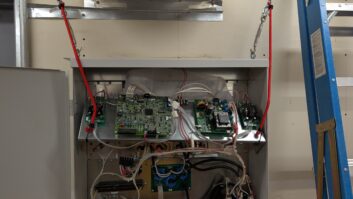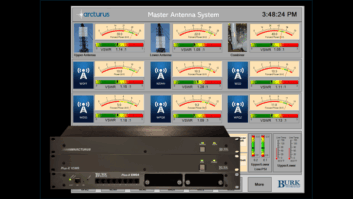Photos
(click thumbnail)Fig. 1: Keep projects and engineering activities organized with a white board like this one, used by Jon Bennett of Cox.
(click thumbnail)Fig. 2: These Accu-Check bottle caps contain a dessicant; their hard plastic construction makes them ideal for toolboxes.For most engineers, the new year brings new budgets and new projects. Make it a point to better organize yourself by adopting a white board to keep track of things to do. In a shop with several engineers, this method of keeping tabs on work to be done ensures that everyone can find something to do. Just look at the board!
In Virgnia, Market Engineer Jon Bennett of Cox Richmond divided his board into three sections. There’s the basic “to do” list, a “special projects” section and a column for IT projects.
In addition to keeping projects from falling through the cracks, a full board of things to do demonstrates to your owner or GM that you have plenty to keep you busy. With that in mind, when a task is completed, don’t erase it; put a check mark by it or run a line through it. Leave it on the board for a few days. Again, it’s a psychological thing. Anyone looking at the board sees your team is productive, getting things done.
So you run a one-man shop? A white board full of things to do helps explain to staff why little things may take a while.
* * *
John Demuth is CE for WTUZ(FM) in Ohio and comments on our discussion about “silica gel desiccant packs” in the Dec. 6 issue of Radio World.
He recalls some excellent packages of silica gel that were enclosed with military surplus gear some years ago. The packages were of heavy cloth and seemed almost indestructible; but even with that kind of construction, they might deteriorate with time.
So here’s another thought. Both John and his wife are diabetic. They use Accu-Chek Compact Blood Glucose Meters. These monitors use a small drum holding 17 sensors. Each drum comes in an airtight plastic bottle with an awesome lid measuring 1-1/8 inch in diameter by 5/8 inches thick.
Why is it awesome? The lid contains a desiccant to keep the drum moisture-free! The bottom of the lid will let the moisture pass into the desiccant, but it is pretty tough material and will take a lot of abuse. A few of those lids could easily be tossed into a toolbox; and if you wanted extra protection, they could be placed into a small cloth bag to keep them contained.
Unfortunately, diabetics abound; an inquiry may lead you to someone who uses this type of glucose monitor. Many hospitals have diabetic support groups and might welcome an opportunity to help their participants recycle the plastic bottles/lids.
The small bottles can also be used to hold screws or other small parts. A typical container is shown in Fig. 2, along with a ruler, to give an indication of size. The white membrane on the underside of the lid is pretty tough, and the lid alone should hold up in your toolbox.
Did you know that you can revitalize silica gel by re-drying it? One of the best ways available to the average person is to place the containers in a warm oven to drive out the moisture. You want the oven hot enough to evaporate the moisture but not so hot as to melt or burn the material surrounding the desiccant. Bake the dessicant at 150 degrees F for a couple hours. Note that some desiccants even change color to indicate whether they are usable (dry) or unusable (ineffective due to having absorbed too much moisture).
Like so many readers, John writes, “I enjoy your Workbench column very much; thank you for providing such a wonderful forum for sharing a never-ending multitude of useful hints, kinks, tips and techniques.” You’re welcome, John!
* * *
Tom Oaklund describes himself as a “retired RF guy.”
Actually, Tom was transmitter supervisor for KPBS(TV/FM) in San Diego from 1995 to 2005. He offers an additional check that should be done periodically on nitrogen tank regulators to ensure proper operation.
Turn off the tank gas valve and valves to the transmission line. Crack a valve on the regulated side slightly and watch as the tank pressure gauge drains down to the 200-pound range. Watch the output pressure gauge to see if pressure remains at the set point, or spikes up beyond the set point as the tank pressure gauge drifts down to zero.
The regulator is operating properly if the set pressure is maintained until tank pressure is equal to the set pressure. At this point, the set and tank pressures should drift down together to zero. If the set pressure
spikes, possibly equal to the remaining tank pressure in a worst case, the regulator may not be a two-stage regulator or it’s a two-stage regulator with problems.
Tom warns to be careful when shopping for nitrogen regulators, and be leery of any you find stashed away. One- and two-stage regulators look basically the same. Test them carefully before connecting to the
transmission line.
* * *
Tom Weber is the engineering maintenance supervisor for LIN Television in Indianapolis. Tom noted the suggestion about covering station vehicle VIN (Vehicle Identification Numbers) to thwart theft. It seems some thieves have copied this number by viewing it through the windshield, then getting the dealership to cut a key for the vehicle.
Tom’s son is a “repo man.” At least in the state of Indiana, it’s illegal to obstruct the VIN on a vehicle. So avoid a fine and check out your jurisdiction before “covering up.”
Submissions for this column are encouraged, and qualify for SBE recertification credit.









